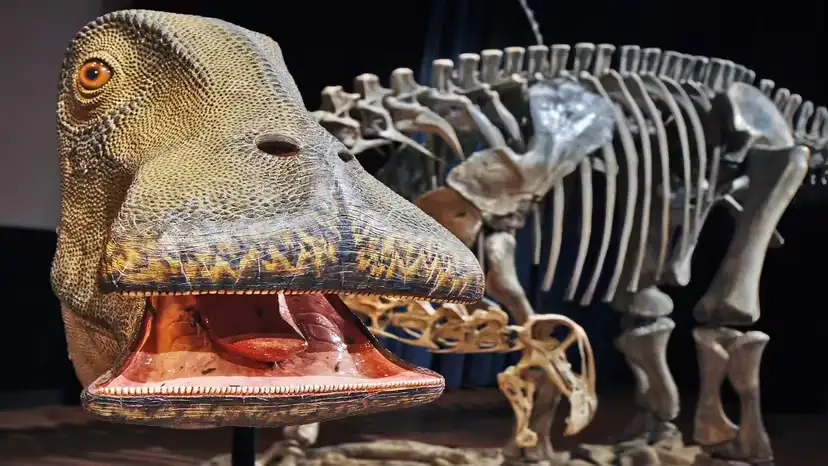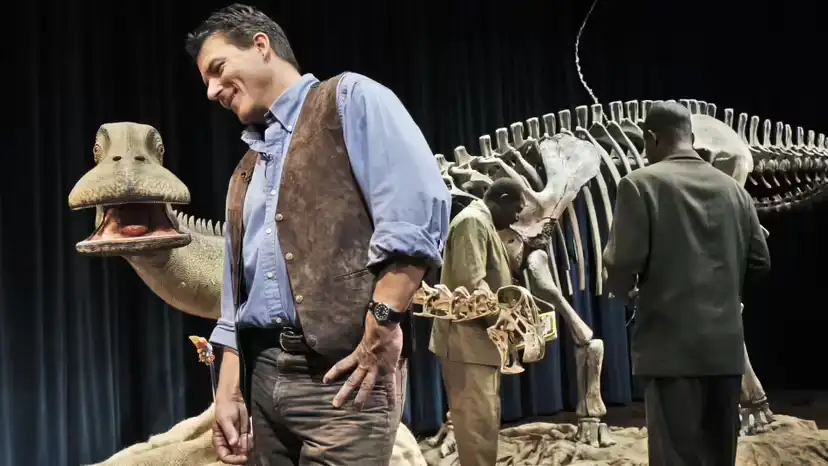Scientific name: Nigersaurus taqueti
Age: Early–mid Cretaceous (~115–105 Ma)
Length / Mass: ~9 m (30 ft) / ~4 t (≈ African elephant class, but lighter build)
Habitat: Lush river plains and floodplains in what is now Niger (southern Sahara)
Claim to fame: Ultra-wide “vacuum-nozzle” muzzle and 500+ teeth arranged in dental batteries for nonstop low browsing
500+ teeth: tightly packed dental batteries (vertical tooth columns); worn teeth were replaced roughly every ~2 weeks.
Front-loaded bite: almost all functional teeth were concentrated right at the snout edge—a wide cutting bar for ground-level grazing.
Small for a sauropod, highly specialized: ~9 m long, short neck, feather-light skull bones, and extremely pneumatic (air-filled) vertebrae.
Lifestyle: low-browsing herbivore in riverine, green Cretaceous Sahara; likely cropped ferns, horsetails, and low angiosperms.

The reconstructed skeleton of a very weird dinosaur, the plant-eating Nigersaurus. This is a sculptural rendition of what the scientists expect the dinosaur's distinct head may have looked like. Behind this, cast reconstructions of the bones have been assembled in the proper shape of the Nigersaurus. Bill O'Leary/The Washington Post/Getty Images
Viewed from above, the muzzle looks like a vacuum cleaner head. The jaws flare laterally, placing tooth rows at the very front of the mouth so the animal could sweep along the ground and shear soft plants efficiently.
Nigersaurus’ upper and lower jaws carried dozens of tooth columns; each column stacked multiple replacement teeth. As the top crown wore down, the tooth beneath moved up to take its place.
Why so many? High-rate cropping rapidly abraded crowns; batteries ensured constant sharp edges without complex chewing motions.
For a sauropod, Nigersaurus was compact. What grabbed paleontologists is the featherweight skull (cranial bone plates ~2 mm thin) and hyper-pneumatized vertebrae (large internal air spaces), cutting mass for energy-efficient head/neck movements close to the ground.
Primary foods: low-growing, soft vegetation (ferns, horsetails, tender angiosperms).
Method: steady, lateral sweeping of the ground cover using the broad, serried cutting edge; no need to reach high foliage.
Why it worked: floodplain habitats had fast-renewing plant growth; dental batteries kept the “blade” sharp.
Early studies using inner-ear (LSC) orientation proposed habitually down-facing head posture (snout ~67° down). Later work cautioned that LSC alone can’t lock in habitual head angle for sauropods.
Reasonable consensus today: definite head-down while feeding; resting/alert posture likely varied with behavior.

Paul Sereno, Ph.D., left, onstage with Nigerian archeologists Dr. Maga Abdoulaye, center, and Dr. Ide Oumarou, right, with the reconstructed skeleton of Nigersaurus.
When: ~115–105 million years ago (Cretaceous).
Where: present-day Niger, then a wet, green mosaic of rivers, woodlands, and floodplains.
Potential threats: giant croc-line predator Sarcosuchus and other contemporaries.
1950s: fragmentary bones collected in the Sahara; no formal name.
Late 1990s: new expeditions recovered much more complete material—about 80% of the skeleton could be reconstructed, revealing the iconic wide muzzle + dental batteries.
1999: formally named Nigersaurus taqueti.
Preservation challenge: paper-thin cranial bones and wafer-light, air-filled vertebrae are hard to preserve and prepare—one reason the animal stayed obscure for decades.
| Feature | Nigersaurus Snapshot |
|---|---|
| Size | ~9 m (30 ft), ~4 t |
| Neck | Relatively short for a sauropod |
| Skull | Very thin bone plates (~2 mm) |
| Teeth | 500+ total including replacements |
| Tooth Layout | Front-loaded dental batteries (upper & lower jaws) |
| Replacement Rate | ~14 days per tooth (estimate) |
| Diet | Low vegetation: ferns, horsetails, tender plants |
| Habitat | Riverine floodplains in Cretaceous Sahara |
| Niche | Low-browser “Mesozoic cow” |
Did Nigersaurus really have 500 teeth?
Yes—counting all active and replacement teeth within the dental batteries. Multiple teeth stacked in each column keep the edge sharp as crowns wear down.
What did it eat?
Mostly low, soft vegetation (ferns, horsetails, low angiosperms), cropped with the broad, forward cutting edge.
Was Nigersaurus huge like other sauropods?
No. At ~9 m/4 t, it was small-to-medium for a sauropod, but highly specialized for efficient low browsing.
Did it always keep its head down?
Head-down feeding is well supported; a permanently down-tilted everyday posture is debated.
Why is its skeleton so delicate?
To save weight: extremely thin skull bones and air-filled vertebrae reduce the energy cost of holding and moving the head/neck.
animal tags: Nigersaurus
We created this article in conjunction with AI technology, then made sure it was fact-checked and edited by a Animals Top editor.